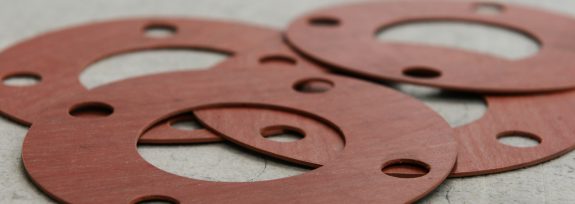Gasket fundamentals
What is the purpose of a gasket? What does a gasket look like? What can you make a gasket out of? What is a flange gasket? This blog covers some basic fundamentals on gaskets and their common use cases.

What is the purpose of a gasket?
A gasket is typically used to help seal two surfaces together. They achieve this by providing a soft contact patch between two surfaces. When a compressive force is applied (for example – whether by screws, clamping of a door, or torquing with bolts), the gasket will compress and effectively seal any uneven areas between the two mediums. Gaskets can be created from incredibly soft materials such as sponge and foam when large compression is required, to very thin but specialized materials to handle extreme pressures, temperatures, and chemical requirements.
What does a gasket look like?
There is no one answer to what a gasket might look like, it depends on its use cases. PRP can produce gaskets conforming to international standards for use in pipelines and common flange types. We can also produce custom gaskets for unique mouldings and housings. If you are unsure, please feel free to contact us and i’m sure we can help!
Can I get gaskets manufactured to custom dimensions?
Yes!, PRP has several different machines that are all capable of cutting gaskets to custom sizes and dimensions, and we can create custom gaskets in a variety of ways. Customers can provide us a drawing or dxf files where we can input directly into our machinery. Alternatively, we can also work from photos and dimensions, or we can even reverse engineer a physical product. We have knife cutting machines, laser machines, routers and die presses, all capable of cutting gaskets to different intricacies or quantities. We can cater to prototypes and small quantities right up to high volume mass production.
What can you make a gasket out of?
Gaskets can be made from a wide variety of different materials. PRP stocks an extensive range of rubber, sponge, foam, plastic, fiber and cork, but we are also capable of cutting materials provided by our customers. For more information on some of our common materials, please click here.
We create various kinds of rubber gaskets using nitrile, butyl, EPDM, neoprene, silicone, natural, insertion and viton rubber. Our gaskets also extend to EPDM and neoprene sponge, foam (such as PE and EVA), non-asbestos fiber, and cork. For specialised pipeline applications, PRP also stocks spiral wound gaskets (SWG) and other metallic varieties for ring-type joints and other piping specifications.
What is a flange gasket?
A flange gasket is a seal between two flanges and is used when connecting two bits of pipe. A flange gasket is typically round in shape and can have holes or no holes depending on the flange type or configuration. Flange gaskets are typically specified by the following common parameters:
Flange specifications or standards – Pipe flanges are manufactured to several specifications and standards, and thus a flange gasket must also be designed to comply with the relevant standard. Typical common international standards include AS 4087, AS 2129, ISO 7005, ANSI B16.5 and BS 1092.
Flange face – As well as different flange types, a flange gasket must also take into consideration the flange face. Typical flange faces include flat-face, raised face, ring-joint (metallic spiral-wound gaskets), lap joint, tongue and groove, and interlocking types such as male/female.
Full-faced vs ring joint – A full-faced gasket is one that sits within the outer dimension of a flange, and thus requires holes cut on a PCD (pitch circle diameter) to accommodate the bolts. A ring joint conversely sits inside the PCD of the flange and therefore has only an outer and inner diameter. These are much thinner, sit on a raised face, and have a simpler manufacturing process.
Gasket material – Finally, in order to specify the correct gasket material, the gas or fluid, chemical resistance, pressure and temperature should be taken into consideration. Materials such as rubber are great for low pressure and temperature configurations, with various compounds used to comply with certain chemical requirements. Nitrile rubber for example is excellent for use against fuels and solvents. Silicone on the other hand can handle up to 250 degrees. Non-asbestos fiber becomes more suitable as temperatures and pressures increase, and these materials are tested over a wide variety of different compliances and approvals. Pressures here can reach up to 120 bar, and our tang graphite materials can also support temperatures up and over 400 degrees C. Spiral wound gaskets are metallic gaskets used for higher pressure applications, and further metallic gasket types can also be utilised dependant on the piping profile or requirements.
If you’d like to understand more about PRP’s custom gaskets and flange gaskets, please click here.
